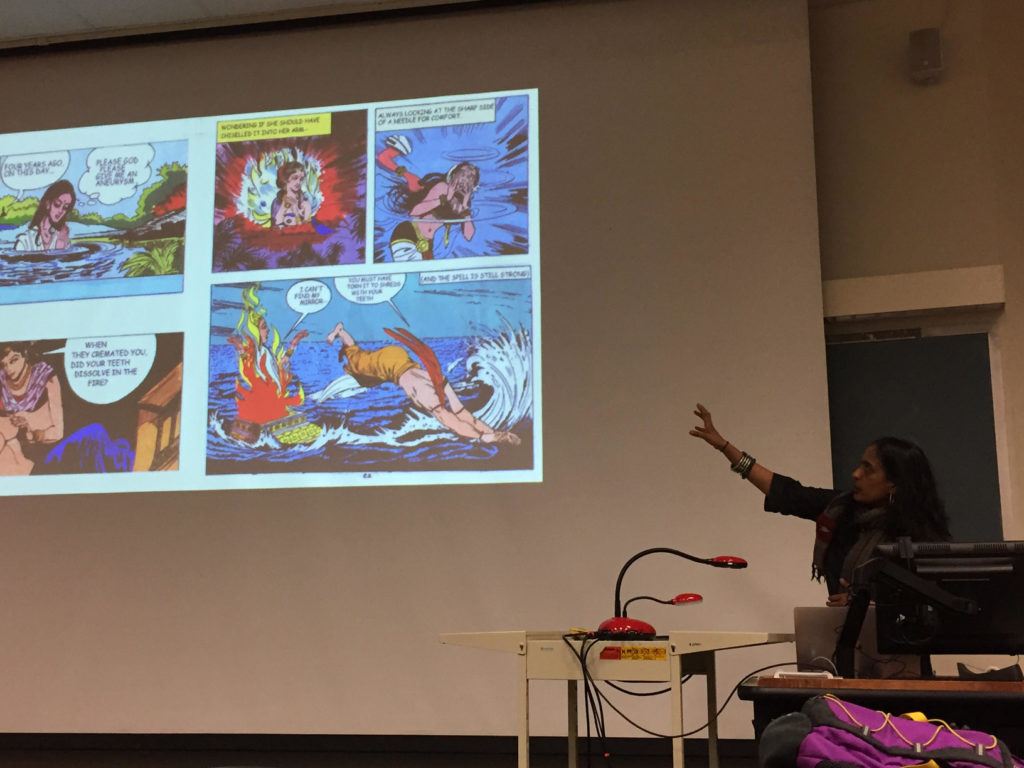Chitra Ganesh provided a diverse portfolio of art pieces as part of the University of Florida’s monthly Visiting Artist Lecture Series. The Brooklyn-based visual artist spoke about her visual art that has come to embody the nature of her career.
“In the lecture series, we want to be diverse in terms of not only just ethnically diverse, but to be democratic in terms of gender and sexuality, but also to show artists who work in a range of fields,” event coordinator Coco Fusco said.
Ganesh’s range of mediums include, but are not limited to, gallery installations, wall drawings, painting, photography, and comics. The focal point of several pieces integrate mythological stories – transporting childhood stories into a visual narrative.
An Indian artist growing up in New York City, Ganesh faced the coalescence of site-specific drawings such as graffiti and an active urban life driving her to embody these experiences as well as the experiences in her home space.
“I grew up in a very tight Indian immigrant community in Queens,” Ganesh said.
New York City lacked the very icons and deities found within her home giving way for these images to first trickle into Ganesh’s art. This multifaceted cultural upbringing included the infusion of cinematic influences from Bollywood films to “Star Wars”. Similar to her background, her artwork throughout the years has branched into different realms in exploration of fairy tales, mythology and femininity. Ganesh also works to deconstruct color barriers in the depiction of non-European figures and the emphasis on light skinned imagery.
“In relation to that very present and full kind of experience of images in the inside world and the New York world, I felt like there was another disjuncture that happened which is that very glaring absence of representation,” Ganesh explained.
In reference to the comics she grew up reading, she noticed the color spectrum: villains were portrayed as darker skinned, heroes were painted in pale tones. The apparent colorism that existed even in art would further push Ganesh to examine her own representations.
Ganesh cites “Afghan Girl”, a 1984 photographic portrait taken by Steve McCurry, as the first encounter with another image of a South Asian individual. This photo, along with countless other images, influenced Ganesh’s search for expression and representation of her subjectivity as a human being.
“Seen in the context of America in the 1980s and the kinds of representations that were out there of subjects from Central or Southeast Asian subcontinent, I felt like there was a huge gap,” Ganesh said.
This very interest would stem her further artworks without neglecting the “vibrant community of New York” she had been a part of.
Aside from the interpretation of representation, Ganesh brings about her art in a manner that explores different mediums for different narratives. A portion of her lecture was devoted to the transformation of stories through the manipulation of physical element.

“Her Nuclear Waters”

Chitra Ganesh presents as part of the University of Florida’s monthly Visiting Artist Lecture Series. Photo by Jasmine Chi

“Excerpts from Tales of Amnesia”
“I’m also interested in the flexibility of the comic form,” Ganesh said.
Within her lecture, Ganesh presented two formats of her comics. For one medium, it simply existed as a traditional comic in which narrative is achieved through the logical progression of chronological order. As the viewer reads and looks at each frame of the comic from left to right, comprehension naturally occurs in the manner of direction. In the second medium, each frame of the comic has been enlarged, framed, and placed onto a wall. None of the frames touch each other, thus altering the process in which the reader understands the narrative. In this schematic, the narrative for each viewer is created based on the implications of a changed physical perspective. Although both are ultimately “comics”, the presentation of the piece has drastic repercussions in each individual viewer’s interpretations.
After September 11, Ganesh analyzed posters and the disappearances of people through special registration, detention, and deportation.
“During and around September 11, there started to be a consolidation of change … there was a change of political climate policies and a kind of way in which immigrants, Muslims, and dissenting communities began to be marked as a necessary way to commemorate the tragedy of September 11,” Ganesh said.
Ganesh and her collaborator created a body of work that would revolve around the absences, not of solely September 11 victims, but of these very individuals erased from the law and from legal documents. Ganesh’s desire to tell stories would lead to the building of an archive of voluntary submissions of information on the “disappeared”.
Through the complexities of cultural identity, Chitra Ganesh strings her stories, history, and strangers’ narratives into works of art. After Ganesh’s talk ended, an attendee said, “It was really good. I enjoyed her talk about modes of transportation about images and iconography.”
The guest appearance of Ganesh would conclude the final lecture of the Visiting Lecture Series until the Fall 2018 semester. The monthly event is sponsored by University of Florida’s School of Art and Art History.
Photos courtesy of Chitra Ganesh